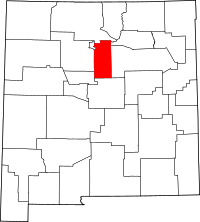San Ildefonso Pueblo, New Mexico
| San Ildefonso Pueblo, New Mexico | |
|---|---|
| CDP | |
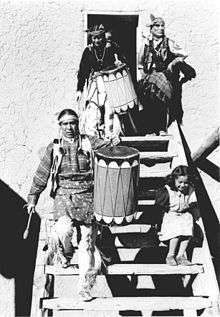 Drummers at San Ildefonso Pueblo, 1942. Ansel Adams, photographer | |
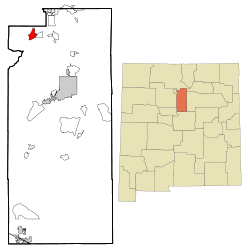 Location of San Ildefonso Pueblo, New Mexico | |
 San Ildefonso Pueblo, New Mexico Location in the United States | |
| Coordinates: 35°53′52″N 106°7′19″W / 35.89778°N 106.12194°WCoordinates: 35°53′52″N 106°7′19″W / 35.89778°N 106.12194°W | |
| Country | United States |
| State | New Mexico |
| County | Santa Fe |
| Area | |
| • Total | 4.2 sq mi (10.8 km2) |
| • Land | 3.9 sq mi (10.2 km2) |
| • Water | 0.2 sq mi (0.6 km2) |
| Elevation | 5,548 ft (1,691 m) |
| Population (2000) | |
| • Total | 458 |
| • Density | 116.7/sq mi (45.1/km2) |
| Time zone | UTC-7 (Mountain (MST)) |
| • Summer (DST) | UTC-6 (MDT) |
| ZIP code | 87501 |
| Area code(s) | 505 |
| FIPS code | 35-68010 |
| GNIS feature ID | 0933092 |
| Website | |
|
San Ildefonso Pueblo | |
 | |
| Nearest city | Espanola, New Mexico |
| Area | 46.8 acres (18.9 ha) |
| Built | 1591 |
| NRHP reference # | 74001206[1] |
| NMSRCP # | 230 |
| Significant dates | |
| Added to NRHP | June 20, 1974 |
| Designated NMSRCP | December 30, 1971 |
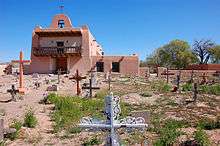
San Ildefonso Pueblo (Tewa: P'ohwhóge Owingeh [p’òhxʷógè ʔówîŋgè] "where the water cuts through"[2][3]) is a census-designated place (CDP) in Santa Fe County, New Mexico, United States, and a federally recognized tribe, established c. 1300 C.E.[4] The Pueblo is self-governing and is part of the Santa Fe, New Mexico Metropolitan Statistical Area. The population was 524 as of the 2010 census,[5] reported by the State of New Mexico as 1,524 in 2012,[6] and there were 628 enrolled tribal members reported as of 2012 according to the Department of the Interior.[7] San Ildefonso Pueblo is a member of the Eight Northern Pueblos, and the pueblo people are from the Tewa ethnic group of Native Americans, who speak the Tewa language.
Geography
San Ildefonso is located at 35°53′52″N 106°7′19″W / 35.89778°N 106.12194°W (35.897902, -106.121834).[8]
According to the United States Census Bureau, the pueblo has a total area of 4.2 square miles (11 km2), of which 3.9 square miles (10 km2) is land and 0.2 square miles (0.52 km2) (5.54%) is water.
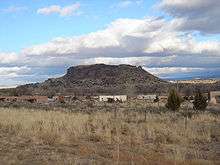
San Ildefonso Pueblo is located at the foot of Black Mesa.
Demographics
As of the census[9] of 2010, there were 524 people residing in San Ildefonso. The racial makeup was 62.2% Native American, 11.3% White, 21.2% from other races, and 5.3% from two or more races. Hispanic or Latino of any race were 31.9% of the population. There were 212 households out of which 29.7% had children under the age of 18 living with them. As of 2010, the population was distributed with 26.3% under the age of 18, 14.3% who were 65 years of age or older, females comprised 51.7%, and males comprised 48.3% of the population.
As of 2000, the median income for a household in San Ildefonso was $30,000, and the median income for a family was $30,972. Males had a median income of $19,792 versus $19,250 for females. The per capita income for the pueblo was $11,039. About 19.1% of families and 14.9% of the population were below the poverty line, including 50.0% of those age 65 or over.
History
The Pueblo was founded when people migrated from the Mesa Verde complex in Southern Colorado, by way of Bandelier (elevation about 7000 feet), just south of present-day Los Alamos, New Mexico. People thrived at Bandelier due to the rainfall and the ease of constructing living structures from the surrounding soft volcanic rock. But after a prolonged drought, the people moved down into the valleys of the Rio Grande around 1300 C.E. (Pueblo IV Era). The Rio Grande and other arroyos provided the water for irrigation.

The Spanish conquistadors tried to subdue the native people and force Catholicism on the native people during the early 17th century, which led to the Pueblo Revolt of 1680. The people withstood the Spaniards by climbing to the top of the Black Mesa. The siege ended with the surrender of the native people, but the Spanish gave the native people some freedom of religion and other self-governing rights.
The people of San Ildefonso continued to lead an agricultural based economy until the early 20th century when Maria Martinez and her husband Julian Martinez rediscovered how to make the Black-on-Black pottery for which San Ildefonso Pueblo would soon become famous. From that time the Pueblo has become more tourist-oriented, with numerous tourist shops existing in the Pueblo. Because of close proximity to the state capital, Santa Fe, and the presence of the Los Alamos National Laboratory, many of those employed in the pueblo have government jobs.
Politics
San Ildefonso is governed by a civil government consisting of an executive branch (the governor) and a legislative branch (the tribal counsel).[10]
In 2006 the SOUTH KIVA group was split as the Gonzales family was forced out of the traditional and political process. The splinter faction fought for proper democratic election of candidates and officers. This resulted in 6 years of continuing governance agreements which allowed for the election of a portion of the legislative branch a compromise and change from the appointment process. The pueblo has experienced significant political controversy in recent years with significant interference from the Bureau of Indian Affairs, and in 2012, the Interior Board of Indian Appeals vacated BIA decisions to "acknowledge" the results of an election for Governor of the Pueblo of San Ildefonso for the 2008/09 term which had resulted in the governorship of Leon Roybal.[11]
In 2012, the Pueblo adopted a new constitution through general election overseen by the Bureau of Indian Affairs. One of the results of the new constitution is that, for the first time, women are allowed to run for tribal council positions.[12][13] To date, there is no publicly available copy of the newly adopted constitution. The 1996 San Ildefonso Code is the most recent available copy of local laws governing the pueblo.[14]
Economic development
The San Ildefonso Pueblo Enterprise Corporation (SIPEC) is a federally chartered Section 17 Corporation which is wholly owned by the Pueblo de San Ildefonso.[15] SIPEC is charged with working with companies and individuals who share a vision of utilizing the Pueblo's strategic location for fostering economic and job growth for the Pueblo de San Ildefonso.
Culture
)_(17537697714).jpg)
The people of San Ildefonso have a strong sense of identity and retain ancient ceremonies and rituals tenaciously, as well as tribal dances.[2] While many of these ceremonies and rituals are closely guarded, San Ildefonso Feast Day is open to the public every January 23.[16] Other dances open to the public include Corn Dance, which occurs in the early to mid-part of September, and dances at Easter.[17]
There was an art movement called the San Ildefonso Self-Taught Group, which included such noted artists as Alfonso Roybal, Tonita Peña, Julian Martinez, Abel Sanchez, Crecencio Martinez, and Encarnación Peña.[18]
Notable people
- Edgar Lee Hewett (1865–1946), Anthropologist instrumental to the development of the San Ildefonso Self Taught Group
- Julian Martinez (1879–1943), pottery artist
- Maria Martinez (1887–1980), pottery artist
- Tonita Peña (1893–1949), watercolor artist
- Awa Tsireh a.k.a Alfonso Roybal (1898–1955), watercolor artist
- Blue Corn (1920-1999), pottery artist
See also
References
- ↑ National Park Service (2010-07-09). "National Register Information System". National Register of Historic Places. National Park Service.
- 1 2 "San Ildefonso Pueblo". Indian Pueblo Cultural Center. Archived from the original on 13 April 2012. Retrieved 16 April 2012.
- ↑ Burns, Patrick (2001). In the Shadow of Los Alamos: Selected Writings of Edith Warner. Albuquerque: U. New Mexico Press. p. 26. ISBN 0-8263-1974-2.
- ↑ "Southwest Region - Tribes Served". U.S. Department of the Interior Indian Affairs. Archived from the original on 22 February 2012. Retrieved 16 April 2012.
- ↑
- ↑ "San Ildefonso Pueblo". New Mexico Tourism Department. Archived from the original on 3 March 2012. Retrieved 16 April 2012.
- ↑ "BIA Southern Plains Regional Office". U.S. Department of the Interior. Archived from the original on 7 March 2012. Retrieved 16 April 2012.
- ↑ "US Gazetteer files: 2010, 2000, and 1990". United States Census Bureau. 2011-02-12. Retrieved 2011-04-23.
- ↑ "American FactFinder". United States Census Bureau. Retrieved 2008-01-31.
- ↑ "San Ildefonso Official Website". Retrieved 5 November 2014.
- ↑ "Pueblo de San Ildefonso Council of Principally v. Acting Southwest Regional Director, Bureau of Indian Affairs" (PDF). 54 IBIA 253 (02/13/2012). Interior Board of Indian Appeals. Retrieved 16 April 2012.
- ↑ "Women Vote In Pueblo Election For First Time". KOAT-TV. Archived from the original on 28 January 2013. Retrieved 16 April 2012.
- ↑
- ↑ "San Ildefonso Pueblo Code". National Indian Law Library. Retrieved April 16, 2012.
- ↑ "Archived copy". Archived from the original on 2012-09-10. Retrieved 2012-05-08.
- ↑ "Feast Days". Indian Pueblo Cultural Center. Archived from the original on 19 April 2012. Retrieved 16 April 2012.
- ↑ "Dances & Events at New Mexico's Native Communities". New Mexico Department of Cultural Affairs. Retrieved April 16, 2012.
- ↑ Wander, Robin (February 22, 2012). "Highlights from Stanford's Native American paintings collection are showcased in Memory and Markets: Pueblo Painting in the Early 20th Century". Stanford News. Stanford University, Cantor Arts Center. Retrieved October 22, 2014.
External links
| Wikimedia Commons has media related to San Ildefonso Pueblo, New Mexico. |
